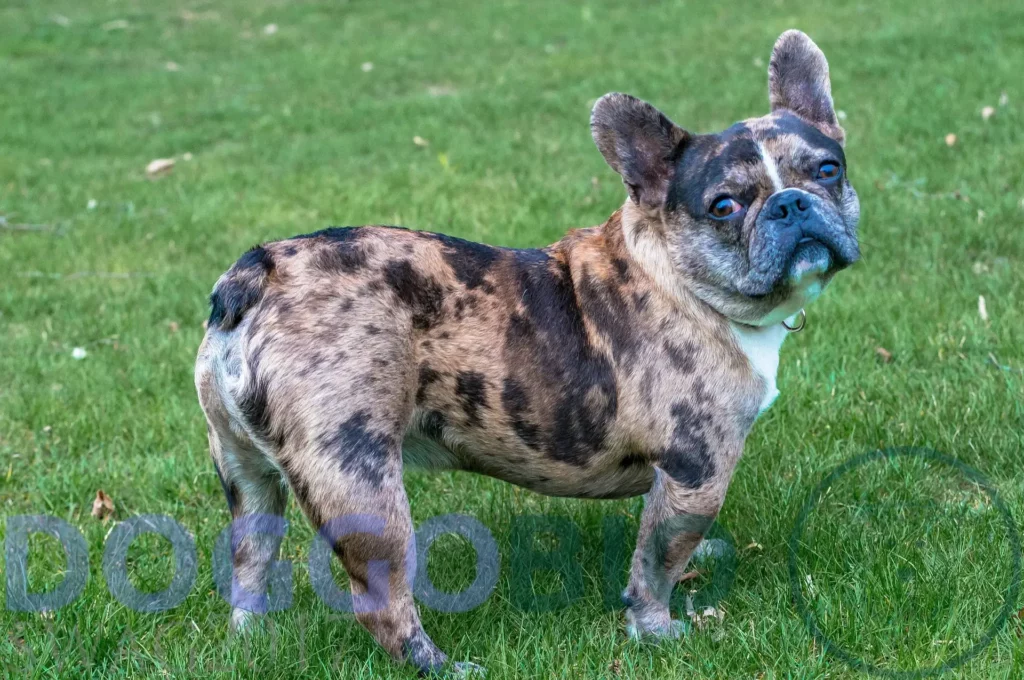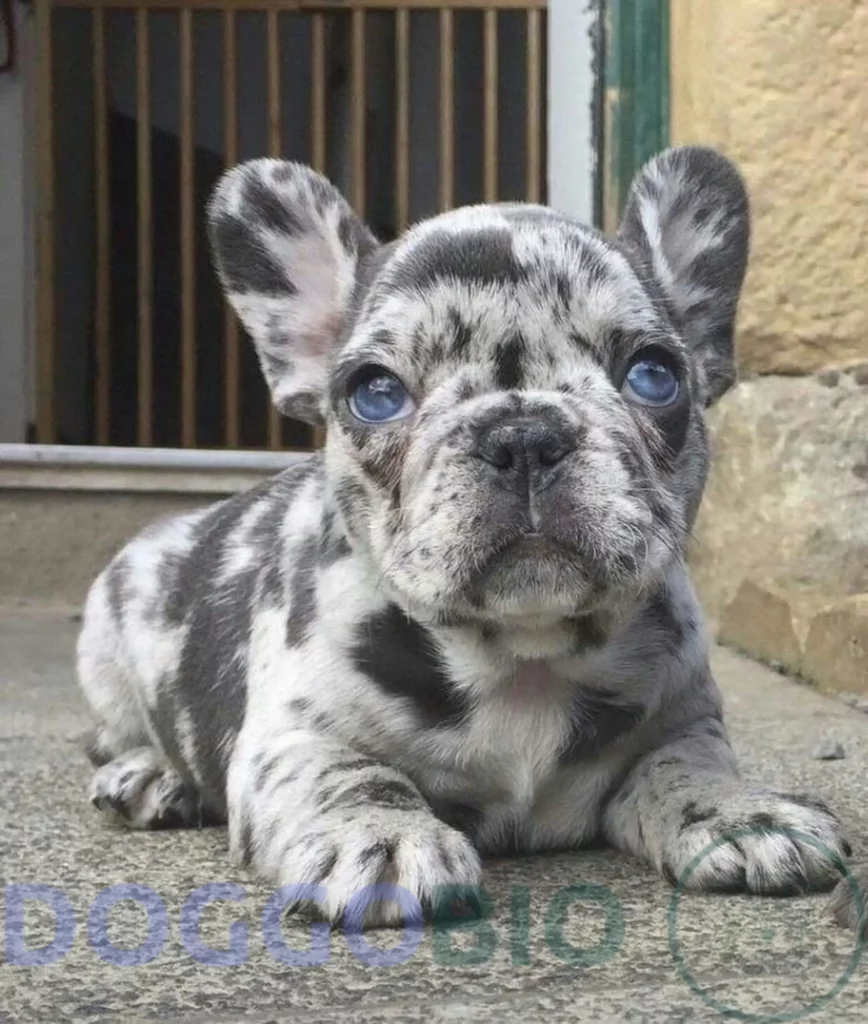The Blue Merle French Bulldog, a captivating and distinctive breed of dog, has captured the hearts of dog enthusiasts worldwide. Renowned for their stunning coat pattern and endearing characteristics, Blue Merle French Bulldogs have become increasingly popular among dog lovers.
This unique variation of the beloved French Bulldog breed exhibits a mesmerizing combination of blue-gray and black patches, creating a visually striking appearance. Alongside their eye-catching coat, Blue Merle French Bulldogs possess a charming personality and a loyal nature, making them not only a delightful companion but also an exquisite addition to any family.
In this article, we will delve into the fascinating world of the Blue Merle French Bulldog, exploring their origin, physical attributes, temperament, and care requirements.
A Brief Overview of Blue Merle French Bulldog
| Breed Name | Blue Merle French Bulldog |
| Size | Small |
| Weight Range | 20-28 lbs |
| Height Range | 11-12 inches |
| Average Lifespan | 11-14 years |
| Coat Colors | Black, Gray, White, Blue Merle |
| Temperament | Friendly, Loyal |
| Average Puppy Costs | $8,000 upwards |
What is a Blue Merle French Bulldog?

The Blue Merle French Bulldog is a unique variation of the breed, recognized for its distinctive coat pattern that can appear in different colors.
The Merle gene causes random dilutions in pigment, affecting the coat, paw pads, nose, and eyes, often resulting in patches and bright blue eyes.
While other French Bulldogs may have blue eyes as puppies, they usually fade with age, but Blue Merle Frenchies often retain this striking eye color throughout their lives.
Controversy about Blue Merle Frenchie
The breeding of Merle French Bulldogs is controversial due to the risk of genetic issues when two merle dogs are mated.
Complicating matters, the merle gene can be hidden in lighter-colored Frenchies, leading to “ghost merles” that may unknowingly pass on the gene, risking double merle offspring with serious health problems.
Responsible breeders mitigate these risks by conducting detailed genetic testing to ensure safe and informed breeding practices. It’s vital to source a Merle Frenchie from a breeder who understands and responsibly manages these genetic complexities.
History of French Bulldog
The Blue Merle French Bulldog has a fascinating history that began in the 1970s with the discovery of their unique coat color. Initially identified in a study by Rassegna Storica Italiana, they gained official recognition in 1998 from the Internationale Zaunezucht Club and the American Kennel Club in 1999. However, it wasn’t until 2017 that they garnered widespread attention, culminating in their acceptance as show dogs in 2018. Today, these charming canines continue to captivate hearts with their distinctive coats and undeniable appeal.
What Does a Blue Merle French Bulldog Look Like?
One of the most striking features of Merle French Bulldogs is their eyes. While regular Frenchies typically sport eyes ranging from dark brown to black, those carrying the merle gene can showcase lighter hues, such as mesmerizing greens or beautiful blues. This distinct trait becomes more pronounced in double-merle French Bulldogs, resulting from breeding two merles together.
In terms of their physique, the Merle French Bulldog possesses a petite yet sturdy frame. They boast a square-shaped head, a well-developed chest, and a subtly muscular build that adds to their charm.

Size, height, and Weight
When it comes to Weight, they typically range from 16 to 25 pounds, with a maximum limit of 28 pounds. As for their height, these delightful canines stand at an average range of 4 to 13 inches.
However, it is essential to note that in some cases, the Merle gene mutation can impact the overall size and Weight of the Frenchie. If affected by health issues related to the Merle gene, they may exhibit a smaller and lighter physique than their non-merle counterparts.
| Age | Weight (Males) | Height (Males) | Weight (Females) | Height (Females) |
| 3 months | 10-14 lbs | 4-6 inches | 8-12 lbs | 4-6 inches |
| 6 months | 17-22 lbs | 7-9 inches | 13-20 lbs | 7-9 inches |
| 12 months | 20-28 lbs | 11-13 inches | 17-24 lbs | 11-13 inches |
| 18 months | 22-30 lbs | 12-14 inches | 19-26 lbs | 12-14 inches |
| 24 months | 24-32 lbs | 12-15 inches | 20-28 lbs | 12-15 inches |
Coat colors and types
Like their fellow Frenchies, their coat exhibits the same length, texture, and thickness characteristics. It is delightfully short, smooth to the touch, and effortlessly stylish. Their overall petite stature sets them apart, maintaining the endearing compactness that defines the breed.
Temperament and Personality
Like their French Bulldog counterparts, Blue Merles are known for their intelligence and trainability, making them a joy to work with and teach new tricks. Their exceptional affectionate nature sets them apart, making them excellent companions. They have an innate ability to form strong bonds with their human family and thrive on love and attention.
However, it’s important to note that Blue Merles may be prone to separation anxiety when left alone for extended periods. This can manifest in excessive barking or other signs of distress. Providing them with proper socialization and ensuring companionship and mental stimulation is essential for their well-being.
Is Blue Merle French Bulldog a good fit for families?
Yes! Blue Merle French Bulldogs are known to make fantastic family pets. They have a gentle and affectionate nature, which makes them an excellent companion for families, including children. They often get along well with kids and can be patient and tolerant in their presence.
Additionally, Blue Merle French Bulldogs can exhibit good compatibility with other pets in the household. Their social and friendly disposition allows them to form harmonious relationships with other animals, creating a peaceful and loving environment for the entire family.
Training

When training Blue Merle French Bulldogs, they can be moderately easy to prepare. However, it’s important to note that they have a reputation for being stubborn, particularly if they feel neglected or lack proper attention. Therefore, it’s crucial to approach their training with patience and persistence.
You can overcome their stubborn tendencies by consistently providing positive reinforcement, using rewards, engaging in interactive training sessions, and teaching them commands and desirable behaviors. Remember, a little extra patience can go a long way in successfully training your Blue Merle Frenchies.
Exercise Requirements
To keep your Blue Merle French Bulldog healthy and happy, consistent exercise is key. Here’s a breakdown by age:
- Puppies (under 12 months): Short, frequent bursts of gentle play and walks to avoid strain.
- Adolescents (12 to 18 months): Aim for around 30 minutes of exercise daily, including walks and interactive play.
- Adults (over 18 months): Increase to about 1 hour of activity per day, including longer walks and jogging.
- Seniors: Maintain around 1.5 hours of moderate exercise daily, adjusting to their needs.
Tailor the routine to your dog’s energy levels and health, and keep an eye on their comfort. With proper exercise, nutrition, and vet care, your Blue Merle Frenchie will thrive!
Living Conditions
Blue Merle French Bulldogs are well-suited for apartment living due to their size. They can comfortably adapt to living in smaller spaces, making them an excellent choice for urban dwellers.
However, it’s important to note that they are sensitive to extreme temperatures and scorching weather. During the summer, providing them with a more relaxed environment and limiting their outdoor activities may be necessary to prevent overheating.
Grooming and Cleaning
Grooming your Blue Merle French Bulldog is straightforward, but important for their well-being:
- Brush their coat regularly to remove dead hair and distribute natural oils.
- Keep their nails trimmed to a comfortable length.
- Check their ears for wax buildup and clean gently as needed.
- Maintain dental health with regular brushing and dental chews.
- Schedule annual check-ups with your vet for overall health and grooming guidance.
Approach grooming with patience and positivity to make it a pleasant experience for your furry friend.
| Grooming Aspect | Frequency |
| Brushing | Twice a week |
| Bathing | Once a month |
| Teeth Brushing | Twice a week |
| Ear Cleaning | Weekly check |
| Nail Trimming | As needed |
Are Blue Merle French Bulldogs Hypoallergenic?
No, Blue Merle French Bulldogs, like other Frenchies, are not considered hypoallergenic. It’s important to note that French Bulldogs do shed regularly despite having short hair.
Twice a year, during the summer and winter months, French Bulldogs experience a more significant shedding period. In the summer, they shed their winter coats to regulate their body temperature and stay cool in the warmer weather. Conversely, they develop a thicker coat to keep themselves warm and shed their lighter summer coat during winter.
If you or someone in your household has allergies, it’s advisable to spend time with a Blue Merle French Bulldog before bringing one into your home to see if any allergic reactions occur. Regular grooming and cleaning practices can also help minimize the impact of shedding on allergy sufferers.
Food and Diet
For optimal health, Blue Merle French Bulldogs require a high-quality diet tailored to their needs:
- Choose reputable brands with quality protein, fats, and essential nutrients.
- Adjust serving sizes based on age, weight, and activity level.
- Monitor weight and adjust portions accordingly with guidance from your vet.
- Consider individual preferences and sensitivities when selecting food.
- Ensure access to fresh water at all times for hydration.
Consult your vet for personalized dietary recommendations to keep your Blue Merle Frenchie happy and healthy.
Are blue Merle French Bulldogs healthy?

No, Blue Merle French Bulldogs are not inherently unhealthy, but their health greatly depends on responsible breeding practices.
The Merle gene itself doesn’t cause health issues; however, breeding two Merle French Bulldogs can lead to ‘Double Merle’ puppies with serious health problems, including vision and hearing impairments.
It’s essential to choose a breeder who avoids such pairings and conducts thorough genetic testing to ensure the well-being of the puppies.
How Long Does a Blue Merle French Bulldog Live?
Typically, male Blue Merle Frenchies can be expected to live between 12 to 14 years, while their female counterparts tend to have a slightly shorter lifespan, ranging from 10 to 13 years.
It’s essential to remember that various factors such as genetics, diet, exercise, and overall health care play significant roles in determining the lifespan of a Blue Merle Frenchie. By providing them with the necessary care, love, and attention, you can help ensure they lead a healthy and fulfilling life, surpassing their expected years with vigor and joy.
How Much is a Blue Merle French Bulldog?
Blue Merle French Bulldogs are highly sought after and can come with a significant price tag. On average, you can expect to pay over $8,000 for a Blue Merle Frenchie.
However, it’s important to note that prices can vary; in some cases, these adorable pups can be priced as high as $50,000. Acquiring a Blue Merle Frenchie can indeed require a substantial investment.
Is Blue Merle French Bulldog The Right Dog For Me?
If you have someone at home who can provide constant companionship to a dog, the Blue Merle French Bulldog might be the perfect fit for you. These adorable pups thrive on human interaction and enjoy being around their loved ones.
However, it’s important to note that Blue Merle French Bulldogs are notorious snorers. If you don’t mind sharing your bed with a furry friend who may produce some audible nighttime noises, this breed can make an excellent canine companion for you.
List of dogs that are similar to Blue Merle French Bulldog
- Merle French Bulldog
- Blue French Bulldog
- Blue Fawn French Bulldog
- Isabella French Bulldog
- Platinum French Bulldog
- Sable French Bulldog
Frequently Asked Questions
Are Blue Merle French Bulldogs purebred?
Yes, Blue Merle French Bulldogs are considered purebred. The merle pattern, while a subject of debate regarding its origin, does not change the genetic status of these dogs as purebred French Bulldogs.
Historical crossbreeding may have introduced the merle pattern, but today’s Merle French Bulldogs are recognized within the breed without affecting their purebred classification.
Are Blue Merle French Bulldogs Rare?
Yes, Blue Merle French Bulldogs are rare. The American Kennel Club (AKC) does not recognize the Blue Merle color as a standard for the breed, which contributes to their rarity. Their unique coat pattern and coloration make them particularly appealing and uncommon, often sought after by enthusiasts and breeders who desire a distinctive pet.
Does the AKC recognize blue Merle French Bulldogs?
No, the AKC does not recognize Blue Merle French Bulldogs. The AKC’s breed standard for French Bulldogs includes colors like black, brindle, cream, fawn, pied, and white, but not Blue Merle or other exotic colors such as lilac, blue, and chocolate.
These non-standard colors lead to disqualification in AKC conformation shows, and dogs with such colors are often not favored by breeders who adhere strictly to AKC standards.
How much is the price of caring for Frenchie?
Caring for a Blue Merle French Bulldog can cost approximately $1500 to $2500 per year, considering factors like nutrition, veterinary care, grooming, training, and supplies. However, expenses may vary based on individual needs and conditions.
Conclusion
In conclusion, the Blue Merle French Bulldog exemplifies beauty, uniqueness, and companionship. This captivating breed has become a beloved favorite among dog enthusiasts worldwide with its striking coat pattern, playful spirit, and unwavering loyalty.
Whether turning heads on a stroll or providing endless love and joy within the home, the Blue Merle French Bulldog leaves an indelible impression on all who can share their lives with this remarkable companion. Embrace the enchantment and cherish the extraordinary bond that awaits with the Blue Merle French Bulldog.

Pingback: Merle French Bulldog: Interesting Facts You Need To Know 2023
Pingback: Blue Fawn French Bulldog: Everything You Need to Know 2023
Pingback: Fawn French Bulldog: Unveiling the Fantastic World 2023
Pingback: Cream French Bulldogs: Beautiful Pups in Cream Coat 2023
Pingback: White French Bulldog: A Complete Guide to charming breed 2023
Pingback: Platinum French Bulldog: Captivating Beauty in a Petite 2023
Pingback: Isabella French Bulldog: Captivating Hearts with Their Rare 2023
Pingback: Pied Frenchies: Experience the Magic of this breed 2023